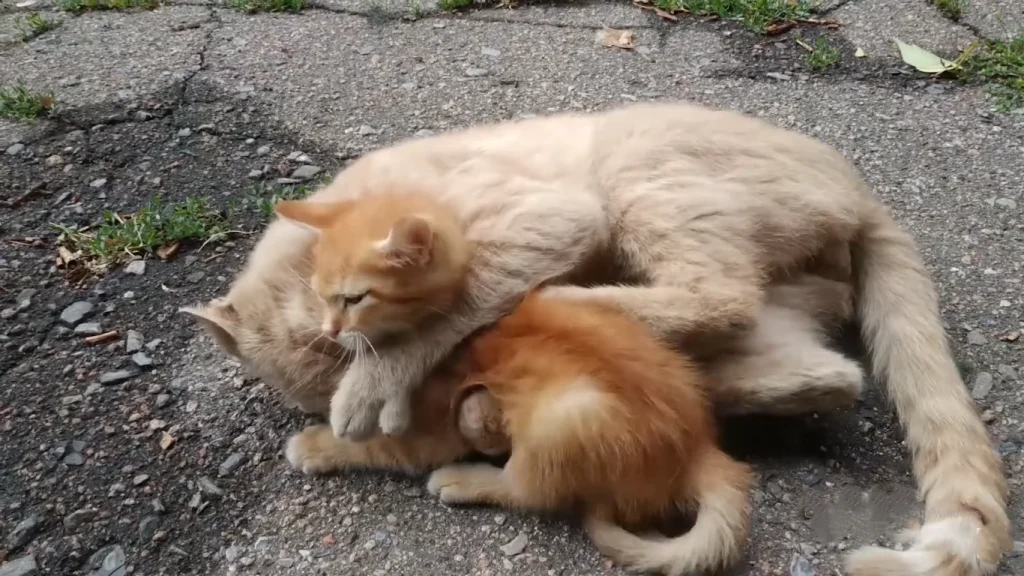How Soon After Kittens Can A Cat Be Spayed? Understanding the Right Timing for Your Pet
By: Elizabeth Rikas

The information in this article is intended to educate cat parents and is not a substitute for veterinary guidance. In case of any concerns about your cat’s health, please talk with your veterinarian.
Cats can bring immense joy, especially when they have kittens. However, once those kittens are born, many pet owners wonder about the right time to spay the mother cat. Veterinarians typically recommend waiting until the kittens are weaned, which usually occurs around 5 to 6 weeks after birth. This timing ensures the health and well-being of both the mother and her young.
Understanding the ideal time for spaying is crucial for responsible pet ownership. Waiting until the kittens are older allows the mother cat to recover better after the stresses of giving birth. Additionally, it helps prevent unwanted litters in the future, contributing to a healthier pet population.
Making sure cats are spayed at the right time can create a positive impact on the wider community. It helps reduce the number of stray animals while also improving the health and behavior of the pets involved.
Key Takeaways:
- Spaying should be done once kittens are weaned, usually at 5 to 6 weeks.
- This practice helps prevent future litters and supports pet health.
- Responsible spaying contributes to a healthier community and reduces strays.
Click to explore the differences between: Male vs Females Cats
Understanding Spaying and Neutering
Spaying and neutering are important processes in pet care. They help control the pet population and provide health benefits for animals. It is essential to understand the differences and advantages of these procedures.
Benefits of Spaying and Neutering
Spaying and neutering offer various benefits for pets and their owners. First, these procedures prevent unwanted litters, which can overcrowd shelters. Reducing the number of homeless animals is a significant advantage.
Spaying females can lower the risk of certain cancers and uterine infections. Neutering males helps prevent testicular cancer and may reduce aggressive behaviors. This can lead to a calmer pet, making them easier to manage.
Moreover, spayed and neutered pets often show fewer behavioral issues, such as marking territory or roaming. This improves the overall quality of life for both the pet and its owner. Regular spaying and neutering also contribute to better hygiene, as they often lead to reduced health risks.
Click to explore the benefits of: Salmon Broth For Cats
Spaying vs. Neutering: Terminology
Understanding the terms “spaying” and “neutering” is essential. Spaying refers to the surgical procedure that removes a female animal’s ovaries and usually the uterus. This procedure prevents her from going into heat and eliminates the ability to conceive.
Neutering, on the other hand, usually refers to the procedure for male animals. It involves removing the testicles, which stops the production of sperm and hormones like testosterone.
While these terms are often used interchangeably, they focus on different aspects of pet sterilization. Knowing the correct terminology helps pet owners communicate effectively with veterinarians. It ensures that they get the proper information and care for their pets.
Click to explore: How To Make Cats’ Fur Softer
Optimal Timing for Spaying Cats
Timing is an important aspect when it comes to spaying cats after they give birth. Knowing when to schedule the procedure can affect both the mother cat’s health and her kittens’ well-being. Various factors play a role in determining the best time to spay a female cat.
Early Spaying Considerations
Spaying a female cat too early can have risks. Vets generally recommend waiting until the kittens are weaned, usually around 5 to 6 weeks after birth. This allows the kittens to become less dependent on their mother for nutrition.
Early spaying, such as at 6 weeks, is possible if the cat is healthy and weighs over 6 pounds. This can prevent unwanted litters and help control the cat’s heat cycles. However, fostering good health during this time is crucial. Owners should consult their veterinarian to decide the best timing.
Factors Affecting Spaying Age
Several factors influence when a cat should be spayed. Health is a primary concern. A vet will assess the mother cat’s physical condition before the procedure.
The cat’s age also matters. Most veterinarians suggest spaying at least 5 to 6 weeks after kittens are born. Additionally, the heat cycle plays a role. If the cat is in heat, waiting a little longer may be better for her recovery post-surgery.
Moreover, individual circumstances, like the living environment and potential adoption plans for the kittens, can also affect timing. Each case should be considered uniquely to ensure the best results for the cat and her kittens.
Post-Operative Care and Recovery
After a cat is spayed, proper care is essential for a smooth recovery. This includes managing her immediate needs and considering her long-term health. The following subsections outline important aspects of post-operative care.
Immediate Post-Surgery Care
In the first 24 hours after surgery, a cat should be monitored closely. It is important to keep her in a quiet, comfortable place to minimize stress. She may be groggy from anesthesia, so offering a soft bed in a calm environment is beneficial.
The cat should not be left alone during this time. She will need help getting up and using the litter box. Feeding should be limited to small portions of water and light food.
The area where the incision is made should be kept clean and dry. If she has a cone collar, it should remain on to prevent her from licking the wound. Watch for any signs of complications, such as excessive bleeding, swelling, or unusual behavior.
Click to learn about: Split Claws In Cats
Long-Term Health Considerations
Long-term, spaying significantly reduces the risk of conditions like pyometra and uterine infections. These are serious health issues that can occur in unspayed cats.
Routine check-ups with a veterinarian are important. This ensures that her recovery is on track and allows for the early detection of any potential health concerns.
A balanced diet and regular exercise will contribute to her overall well-being. Spayed cats can sometimes experience weight gain, so maintaining an active lifestyle is key.
Monitoring behavior and health post-surgery helps in keeping any issues at bay. Regularly scheduled veterinary visits will keep her healthy in the years to come.
Spaying and the Broader Community
Spaying plays a crucial role in managing cat populations, particularly among feral and stray cats. It helps control unwanted litters and reduces the strain on animal shelters. Understanding the impact of spaying on these populations is essential for creating healthier communities.
Click to learn: Why is my cat breathing rapidly?
Impact on Feral and Stray Cat Populations
Feral and stray cats often contribute to overpopulation in urban areas. When unspayed females give birth, they can produce multiple litters each year, leading to even more cats on the streets. This cycle creates challenges for local communities, including increased instances of disease and strain on resources.
Spaying these cats can effectively break this cycle. By preventing unwanted litters, communities can reduce the number of feral cats. This leads to fewer cats needing care and support, helping to improve the overall health and safety of neighborhoods.
Significant efforts have been made to implement trap-neuter-return (TNR) programs. These programs help manage feral cat populations while allowing cats to remain in their familiar territories.
The Role of Animal Shelters and Clinics
Animal shelters and clinics play a vital part in promoting spaying and neutering. They often provide services at low or no cost to encourage more pet owners to participate. By lowering financial barriers, shelters help ensure that more cats are spayed, reducing the overall cat population.
Shelters also educate the public about the benefits of spaying. They inform pet owners about how spaying reduces health risks for cats and prevents unwanted litters. Many shelters partner with local spay/neuter clinics to offer community outreach programs.
Animal shelters serve as a refuge for many stray and feral cats. Their commitment to spaying can lead to healthier cats, stronger communities, and better animal welfare outcomes. This proactive approach helps manage cat populations effectively and responsibly.
Click to know: Do cats like to be petted?
Frequently Asked Questions
Many cat owners have questions about spaying their cats after they have given birth. Understanding the timing and process can help ensure the health and well-being of both the mother and her kittens.
Conclusion
Spaying a cat after she gives birth is a responsible decision that benefits both the mother and her kittens. Veterinarians recommend waiting until the kittens are weaned, typically around 5-6 weeks, to ensure the mother’s full recovery and proper care for her litter. This timing helps prevent future unwanted pregnancies while supporting the cat’s long-term health.
Beyond individual pet care, spaying contributes to reducing stray populations and promoting community well-being. By choosing the right time for the procedure, pet owners play a vital role in animal welfare. Responsible spaying leads to healthier cats, fewer behavioral issues, and a more balanced pet ecosystem.

About the Author
Elizabeth Rikas
Elizabeth is a passionate advocate for feline health and well-being, drawing from her years as a dedicated pet parent to three cats—Gypsy, Swan, and Alfred—and her invaluable experience volunteering at animal shelters. A seasoned writer with a lifelong love for cats, Elizabeth began sharing her insights in her teens and has since contributed extensively to platforms focused on feline care. Through her expertise and heartfelt dedication, she empowers pet owners with practical advice and research-backed knowledge to nurture their furry companions.
